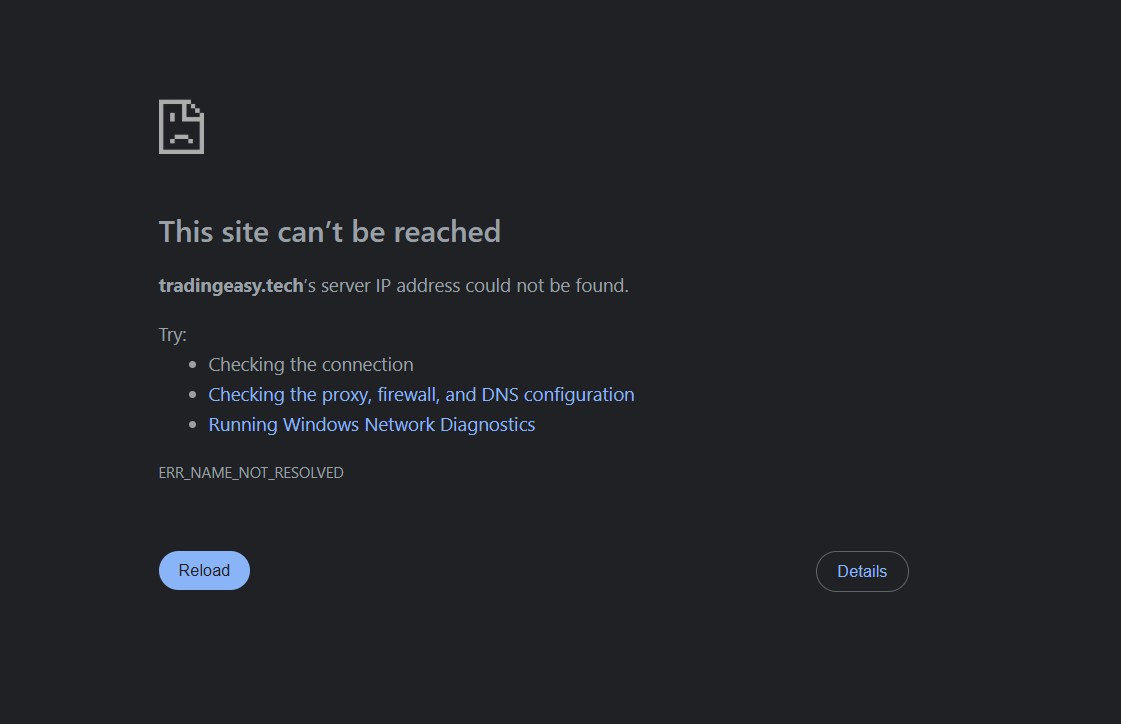TradingEasy.tech Scam Review -A Dubious Broker
Opening — the too-easy demo that felt like a setup (investor vignette)
Daniel stumbled across TradingEasy.tech after a short video promised “AI signals, instant returns, zero hassle.” The site looked modern: animated dashboards, friendly team photos and a promise of a “managed portfolio” that did the heavy lifting. A chat popped up within minutes offering a walkthrough. The rep sounded competent, invited Daniel to deposit a modest test amount, and showed a tidy dashboard that immediately reflected gains.
That small initial win lowered his guard. A few days later, when Daniel tried to withdraw a larger sum, the tone shifted: new verification steps, unexpected “processing” charges, and vague, shifting timelines. The quick replies stopped. That arc — polished onboarding, early small payouts, then blockage when funds get larger — is a recurring pattern seen across risky platforms and it’s the lens we use in this review of TradingEasy.tech.
Short verdict (risk-based)
TradingEasy.tech displays multiple practical warning signs that collectively create a high-risk profile. The platform’s strong marketing and user-friendly surface are not matched by transparent corporate disclosure, verifiable regulatory claims, or consistently documented withdrawal behaviour. Taken together, these indicators suggest TradingEasy.tech should be treated cautiously and considered high-risk for anyone placing meaningful funds on the platform. This is a risk-based assessment, not a legal finding.
1) Polished marketing, thin verifiable facts
A professional website and slick interface are easy to produce — they do not equal trustworthiness. Legitimate financial providers pair marketing with concrete, checkable facts: a clear legal entity, a company registration number, named executives you can verify, a disclosed regulator with licence numbers, and named custodial/banking partners.
TradingEasy.tech places emphasis on performance visuals and product descriptions, but public, checkable corporate details are minimal or vague. Where one expects a simple registration number or a named compliance officer, the site offers promotional copy. That mismatch — professional sheen without obvious verifiable anchors — is a common early red flag.
2) Who’s accountable? — ownership opacity matters
One of the simplest risk checks is discovering who you can hold accountable. Red flags in this area include privacy-protected domain registrations, “about” pages using stock photography and generic biographies, virtual office addresses, and contact routes that funnel to web forms rather than verifiable corporate channels.
TradingEasy.tech’s public footprint shows several of those opacity traits. When ownership is obscured or leadership is anonymous, pursuing complaints or regulatory channels becomes far harder — and that practical difficulty matters a lot when money is at stake.
3) Regulation — the missing guardrail
Regulation provides enforceable consumer protections: client money rules, audits, minimum capital requirements and complaints processes. Trustworthy trading platforms display regulator names and licence numbers so users can independently verify them.
In TradingEasy.tech’s case, regulatory disclosure is vague. General statements about “compliance” or “working with partners” are not the same as being licensed themselves. Without a clearly checkable licence from a recognised authority, users lack a primary external safeguard that reduces many common abuses.
4) Onboarding funnel — warmth that accelerates deposits
Risky platforms frequently use a similar onboarding pattern:
-
Frictionless signup and immediate personal outreach.
-
A demo or small early payout to build confidence.
-
Urgent, time-limited offers to increase deposit size (VIP plans, bonuses).
-
Escalating verification and unexpected charges at withdrawal time.
TradingEasy.tech follows much of this playbook: quick contact, account managers advocating upgrades, and “limited” offers that encourage rapid scaling of deposits. That funnel is highly effective at increasing money under control before users have time to verify essential safety signals.
5) Deposit vs withdrawal asymmetry — the operational litmus test
The most telling empirical test is simply: how does the platform treat funds going in versus funds trying to come out?
-
Deposits are often processed fast and across multiple rails.
-
Risky sites typically allow a small test withdrawal (or stage one payout) to build confidence.
-
Once withdrawals become meaningful, new hurdles appear: suddenly requested documents, surprise fees or long unexplained delays.
Reports and complaint patterns linked to platforms of TradingEasy.tech’s type often mirror this exact sequence. If you encounter “easy in, hard out,” that asymmetry is a very strong, practical warning sign.
6) Testimonials and dashboards — persuasive, not proof
Screenshots of profit graphs, curated testimonials and user quotes are powerful conversion tools, but they are internal artifacts. Real verification looks different: exportable transaction statements, named custodial partners, third-party audits, or reconciled bank/trade records.
TradingEasy.tech’s on-site proofs are persuasive but lack those independent anchors. Without externally verifiable evidence, marketing materials remain exactly that — marketing — not proof of reliable operations.
7) Contractual levers — read the fine print
The practical levers used to delay or deny payouts live in the small print. Watch for clauses that:
-
Allow the operator to freeze accounts for vague “security” reasons.
-
Introduce retroactive “processing” or “release” fees at withdrawal time.
-
Require impossible turnover conditions tied to bonuses.
-
Force dispute resolution in distant or impractical jurisdictions.
If TradingEasy.tech’s terms contain broadly worded discretionary provisions, those are the mechanisms that will likely be used when customers try to withdraw significant sums.
8) Customer support behavior — sales vs service
Another useful real-world test is responsiveness behavior: sales teams are often very prompt before deposit; support becomes slow or evasive after payout requests. Reputable firms keep consistent, documented support trails. If the tone shifts from enthusiastic prospecting to templated or delayed responses once funds are sent, that is a practical operational red flag — and it’s a pattern reported in many problematic platforms.
9) Technical signals & rebrand risk
Technical cues such as very recent domain registration, WHOIS privacy masking, and hosting choices that mirror other short-lived finance sites increase operational fragility. Operators can rebrand or vanish more easily when those features are present. TradingEasy.tech exhibits several technical traits that make sudden name changes or disappearances easier, which raises the practical risk for users who keep funds on the platform.
10) Quick red-flag checklist — one page you can use now
Before sending money to TradingEasy.tech, run this pragmatic filter:
-
Is the legal company name, registration number and physical address published and independently verifiable?
-
Does the platform display a verifiable licence from a recognised financial regulator?
-
Are custodial banks or third-party auditors named and checkable?
-
Do independent users document successful, large withdrawals (not just tiny tests)?
-
Is the domain ownership transparent or is it masked behind privacy protection?
-
Are withdrawal terms, fees and bonus conditions clearly disclosed in advance?
-
Do account managers pressure you to upgrade or deposit more before you’ve tested withdrawals at scale?
-
Do the terms grant the operator broad unilateral powers that could be used to freeze funds?
Multiple “no” answers on that checklist significantly increase the chance of loss.
Analytical conclusion — why the cumulative pattern matters
Any single missing disclosure can be benign: new firms may be imperfectly documented or marketing may be exuberant. The practical danger arises when multiple issues converge. TradingEasy.tech combines glossy marketing and rapid human outreach with opaque ownership, weak verifiable regulation, persuasive upsell mechanics and repeated operational narratives where withdrawals become problematic. That constellation of signals is the same pattern that has preceded losses on many other platforms.
This analysis is a risk-based assessment designed to surface concrete, testable indicators you can use to protect capital. Until TradingEasy.tech publishes clear, independently verifiable company registration, a checkable regulator licence, named custodial partners, audited performance evidence and a consistent history of reliable withdrawals, treat it as a high-risk platform and avoid depositing meaningful funds.
Report TradingEasy.tech Scam and Recover Your Funds
If you have lost money to TradingEasy.tech Scam, it’s important to take action immediately. Report the scam to Jayen-consulting.com, a trusted platform that assists victims in recovering their stolen funds. The sooner you act, the better your chances of reclaiming your money and holding these fraudsters accountable.
Scam brokers like TradingEasy.tech continue to target unsuspecting investors. Stay informed, avoid unregulated platforms, and report scams to protect yourself and others from financial fraud.
Stay smart. Stay safe.






